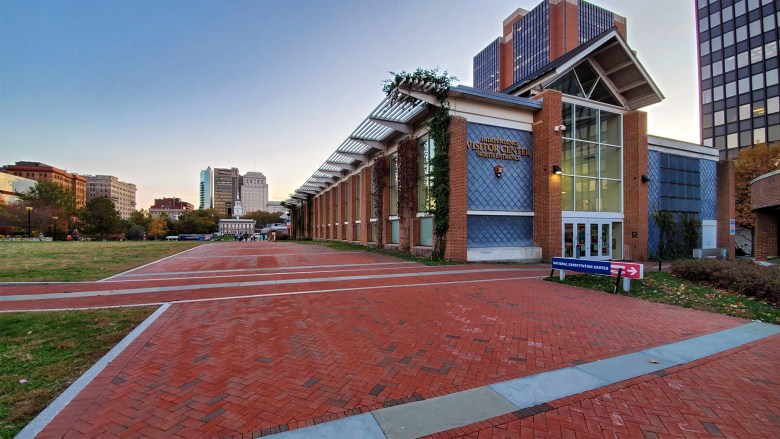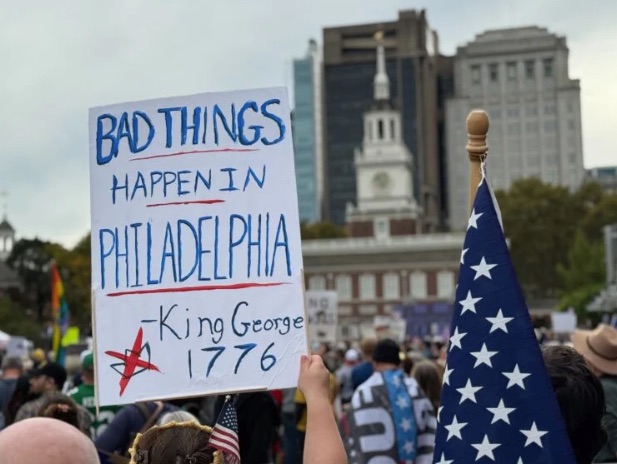Thousands of people gathered in Center City on Saturday to protest the actions of the Trump Administration, starting at City Hall and marching to Independence Mall for a rally that featured impassioned speeches and America’s ever-improving signage. It followed a similar, if larger, march in June.
WHYY’s Aaron Moselle was there and filed this report.
As the third week of the government shutdown begins, Billy Penn provides this status update on where we are with the shutdown and other actions that have drawn the ire of “No Kings” protesters over the past six months.
What’s closed — and what’s open — around Philly
Historic Independence National Historical Park remains shuttered, meaning visitors can only peer through gates at Independence Hall and the Liberty Bell. The National Park Service furloughed many of its local staff, leaving maintenance crews stretched thin and advocacy groups worried about permanent layoffs if the shutdown continues
Visit Philadelphia has provided this list of what is closed, and what is open.
 Independence National Historical Park closed Wednesday on the first day of the shutdown. Furloughs and work without pay are in the offing for many federal employees. (Billy Penn file photo)
Independence National Historical Park closed Wednesday on the first day of the shutdown. Furloughs and work without pay are in the offing for many federal employees. (Billy Penn file photo)
These attractions are closed:
Liberty Bell Center
Independence Hall
Franklin Court
The Benjamin Franklin Museum
Rose Garden
Magnolia Garden
Benjamin Rush Garden
18th Century Garden
The African-American Museum remains closed due to the installation of their next exhibit, Ruth E. Carter: Afrofuturism in Costume Design (re-opening on November 1).
These are open:
Attractions that operate entirely without federal funds or the support of federal employee, including: National Constitution Center, American Philosophical Society, Christ Church and Christ Church Burial Ground, Carpenters’ Hall, Elfreth’s Alley, Franklin Square, Betsy Ross House, Museum of the American Revolution, Independence Seaport Museum, Cherry Street Pier, Powel House and Hill-Physick House, National Liberty Museum, Museum of Illusions Philadelphia, Mother Bethel AME Church and the Richard Allen Museum, Gloria Dei Episcopal Church
Independence Visitor Center
Arts and culture museums, including the Philadelphia Art Museum of Art, Calder Gardens, The Barnes Foundation, Pennsylvania Academy of the Fine Arts, The Franklin Institute, The Academy of Natural Sciences, Philadelphia Zoo and the Penn Museum
Weitzman National Museum of American Jewish History remains open on weekends (Friday through Sunday, 10 a.m. until 5 p.m.)
United States Mint will remain open during the government shutdown
Philadelphia’s U.S. Immigration Court has paused most hearings, except for emergency cases involving detainees. Federal employees across city offices, from HUD’s regional headquarters to the EPA’s Mid-Atlantic division, have received furlough notices. Essential workers — TSA agents, air traffic controllers, postal carriers, and certain law enforcement officials — are still reporting for duty, but most are now working unpaid.
 A private security guard stands at the entrance to the Liberty Bell Center, which has been closed to the public since the shutdown of the federal government on Oct. 1. (Emma Lee/WHYY)
A private security guard stands at the entrance to the Liberty Bell Center, which has been closed to the public since the shutdown of the federal government on Oct. 1. (Emma Lee/WHYY)
Vital services taking hits
Key support programs are fraying as federal funding dries up. Roughly 2 million Pennsylvanians face uncertainty over November SNAP (food stamp) benefits after the Agriculture Department’s reserves ran out mid-October. While Medicaid and Social Security remain funded automatically, Social Security field offices in Center City have scaled back in-person assistance and stopped issuing income verification letters — a vital document for housing and benefits eligibility.
Local nonprofits are already reporting an uptick in demand for food and rent aid. Philabundance and other hunger-relief organizations say lines have lengthened since the shutdown began.
Federal workers feeling the strain
Pennsylvania’s 66,000 federal civilian employees — including approximately 32,000 in Philadelphia — are either furloughed or working without pay. Contractors, unlike direct employees, are unlikely to receive back pay once the closure ends. While active military members received an October 15 paycheck through reallocated Pentagon funds, future pay remains uncertain.
Union leaders representing local National Park Service and Veterans Affairs workers say morale is low, and that Trump administration “reduction in force” directives — orders to lay off thousands of workers — have intensified anxiety. A federal judge issued a temporary restraining order halting some RIF notices last week, but thousands remain in limbo.
The politics behind the paralysis
The shutdown began October 1 after a dispute between the Republican-controlled Congress and Democrats over whether to extend federal Affordable Care Act subsidies. President Donald Trump has framed the standoff as a push to “shrink bloated government,” while Democrats argue it’s a targeted pullback of essential health and welfare funding.
For now, no new negotiations are scheduled until early next week — meaning the closures, delays, and furloughs will continue into late October.

